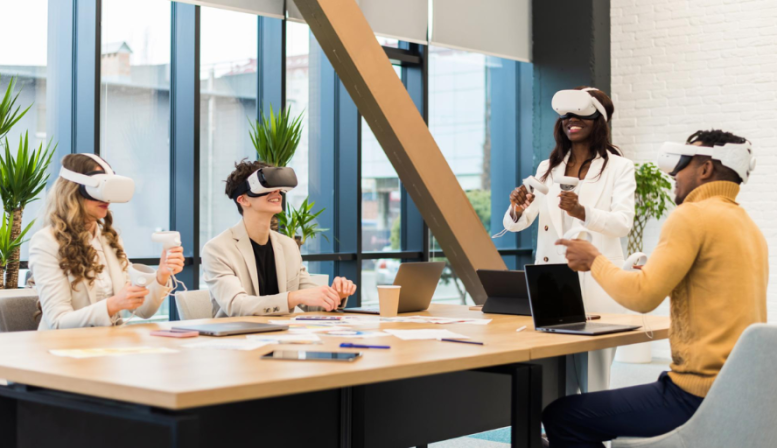The Future of Public Speaking: How AR and VR Are Changing the Game

Imagine holding a speech in a virtual auditorium filled with an attentive audience, all while wearing a headset in your living room. No, this isn’t some dystopian fantasy—it’s the reality of public speaking in the digital age.
We’ve all had our fair share of virtual meetings over the last few years. Love them or hate them, online meetings are here to stay. And with the help of augmented reality (AR) and virtual reality (VR), we can stay connected and transition to this modern conversation style.
As we adapt to this new communication era, let's see how mixed reality training can enhance your public speaking skills.
What Are AR and VR?
Augmented reality is a technology that superimposes computer-generated virtual elements such as images and videos onto the real world, creating an interactive experience.
Conversely, virtual reality immerses users in digital environments, blocking out the physical world for a fully virtual experience.
When applied to public speaking, both play distinct yet complementary roles.
How to Get Started With AR and VR in Public Speaking
Humans are inherently social creatures, and effective communication is a cornerstone of our existence. It’s necessary for success in various fields.
If you’re interested in trying mixed reality techniques to improve your presentation skills, you must follow these steps:
-
Choose the appropriate equipment such as headsets or smartphones with AR capabilities.
-
Select software or apps designed for public speaking training in AR or VR.
-
Familiarize yourself with the setup and features of your chosen platform.
-
Begin with basic exercises and gradually advance to more complex scenarios to build confidence and skill.
Your aim should be to improve essential presentation elements such as boosting your confidence, speaking with passion and authenticity, and connecting with your audience.
Remember that people are driven by emotions, even in an entirely virtual environment. Every good speaker knows how to pull on the heartstrings of their listeners. So even if you’re speaking about the future of business communications, how to route calls, and leverage artificial intelligence (AI), learn how to captivate your audience using emotion.
How to Use AR in Public Speaking
So, let's discuss how AR is changing public speaking training and presentations.
Say you're a lecturer wearing AR glasses or using a smartphone app. These tools can give you on-the-spot prompts and feedback while you're presenting, helping you keep your audience engaged and informed.
For instance, you can see your speech notes right in front of you without looking down at your cue cards. This way, you can maintain eye contact with your listeners and make fewer pauses. Plus, AR can generate visualizations for your audience, such as quizzes or 3D models, bringing your presentation to life.
Interacting with your audience in real time is the main strength of an AR presentation. It’s one thing to explain to your listeners how your product functions and looks. It’s another to show your creations directly to your potential customers with realistic digital models.
For example, companies like Hypersay use AR to create interactive presentations where the audience can participate using their smartphones. It's all about making public speaking more engaging and effective.
A Case of Accessibility
As of today, tools such as Blender or Unity mainly develop AR presentations. If you’re familiar with these, you’d know they’re used for creating animated movies and video games. As such, there is a steep learning curve for the average person to create their own AR presentations.
With that being said, as these technologies develop, over time we can expect that they’ll become much more accessible and anyone will be able to make their own AR slideshows.
Uses of VR for Public Speakers
Can a VR meeting replace a video conference or an in-person conversation? The answer depends on the specific goals and context of the conversation. VR can redefine how public speakers engage with their audience and can be applied in the following scenarios:
-
Global conferences: Speakers from all over the world can participate in webinars and forums. Creators can be truly global, connecting different cultures and industries. You can use AR to incorporate real-time language translation, connect with a diverse audience, and break cultural barriers.
-
Virtual learning environments: You can host online teaching rooms and present your courses with virtually no travel costs.
-
Exclusive virtual experiences and showcases: Proximity no longer limits exhibitions, product showcases, and entertainment. With the right VR equipment, you can attend concerts and expos from the comfort of your home.
-
A bonding experience for remote teams: VR can be a great substitute for in-person communication when physical distances are an obstacle. As more companies expand their business operations across the globe, teams rarely see each other face to face, especially if they work with freelance partners from different locations.
-
Simulation training and education: VR offers training for advanced industries such as medicine, robotics, and aviation. For example, companies like Meta offer virtual training for professionals in these fields. Meta has observed that people who use their VR experience show improved quality of work and customer outcomes.
The Best VR Tools for Public Speakers
If you’ve got a headset, you can practice your public speaking skills with one of the following VR assistants:
-
VirtualSpeech: Explore roleplay exercises and real-life scenarios in over 40 VR environments and receive feedback on your performance.
-
Mursion: It’s another great software to train your interpersonal skills using VR. Its website features plenty of case studies showcasing its positive impact on businesses and schools.
-
Ovation: Learn how to communicate effectively and practice for an upcoming speech using different scenarios and prompts.
-
Rehearsal: It’s an AI-powered tool offering personalized feedback, soft skills training, and VR communication courses.
This is only a small sample of the VR presentation assistants available out there. Start exploring and find out what works best for you.
How AR and VR Can Help With Public Speech Anxiety
Many people struggle with stage fright. We’ve all seen it—an embarrassing speech at a friend’s wedding party or an awkward impromptu interview with a pedestrian.
Delivering a captivating speech takes skill and talent that not everyone possesses. If you face challenges in public speaking, using AR and VR tools can be the solution:
-
Overcoming stage fright: You can use VR to simulate speaking in front of a friendly audience, gradually building confidence.
-
Improving body language: Do you worry about your facial expressions and what to do with your hands during a speech? With VR, you can practice in digital environments that offer real-time feedback on your posture and gestures.
-
Self-paced learning: There’s no need to rush. You control the pace of your learning practice in VR, reducing performance pressure and anxiety.
-
A safe and controlled environment: Practice presenting without the fear of judgment. You control your virtual space, and you’re free to experiment and make mistakes with no real-life consequences.
The Future Implications
As jobs become more remote and the use of AI tools becomes the norm, we’ll be communicating a lot more online than in real life.
According to surveys, 35% of companies worldwide report using AI. More are expressing intent to incorporate it into their business practices, like using AI in content marketing or workflow automation. This indicates an increasing demand for such technologies and paints a bright future for VR and AR.
Additionally, mixed reality tech can make public speaking training more accessible. As it becomes more widespread, a broader audience will be able to engage in a risk-free, lifelike experience that offers real-time feedback and engagement with virtual audiences.
Can Mixed Reality Replace In-Person Meetings?
While AR and VR can offer immersive digital meeting experiences, they cannot fully replace in-person communication. Face-to-face conversations provide a human connection with physical cues and a level of engagement that technology cannot yet replicate.
However, VR and AR meetings can be a valuable supplement, offering many benefits for remote collaboration. The choice between in-person and digital meetings depends on the context and goals of the meeting. Striking the right balance between the two is the most effective approach.
Conclusion
In every aspect of life, the ability to communicate, reach others, and build connections is the foundation for success.
With that in mind, mixed reality seems destined to be an integral part of the future of collaboration and networking. Innovative technologies shape contemporary public speaking, offering an array of possibilities for speakers to connect with and captivate their audience.
While they may only partially replace in-person meetings, AR and VR are shaping up to be essential tools for enhancing public speaking skills and human connection. As the demand for AI technologies grows, we can look forward to a more connected world.
About the author:
Nikola Baldikov is a skilled SEO expert who is dedicated to helping businesses thrive. He is the esteemed founder of InBound Blogging, where his expertise lies in search engine optimization and crafting effective content strategies. Throughout his career he has had the pleasure of collaborating with a wide range of companies regardless of their scale and has consistently aided them in accomplishing their objectives online. During his leisure time. He finds joy in engaging in football matches and dance routines.





